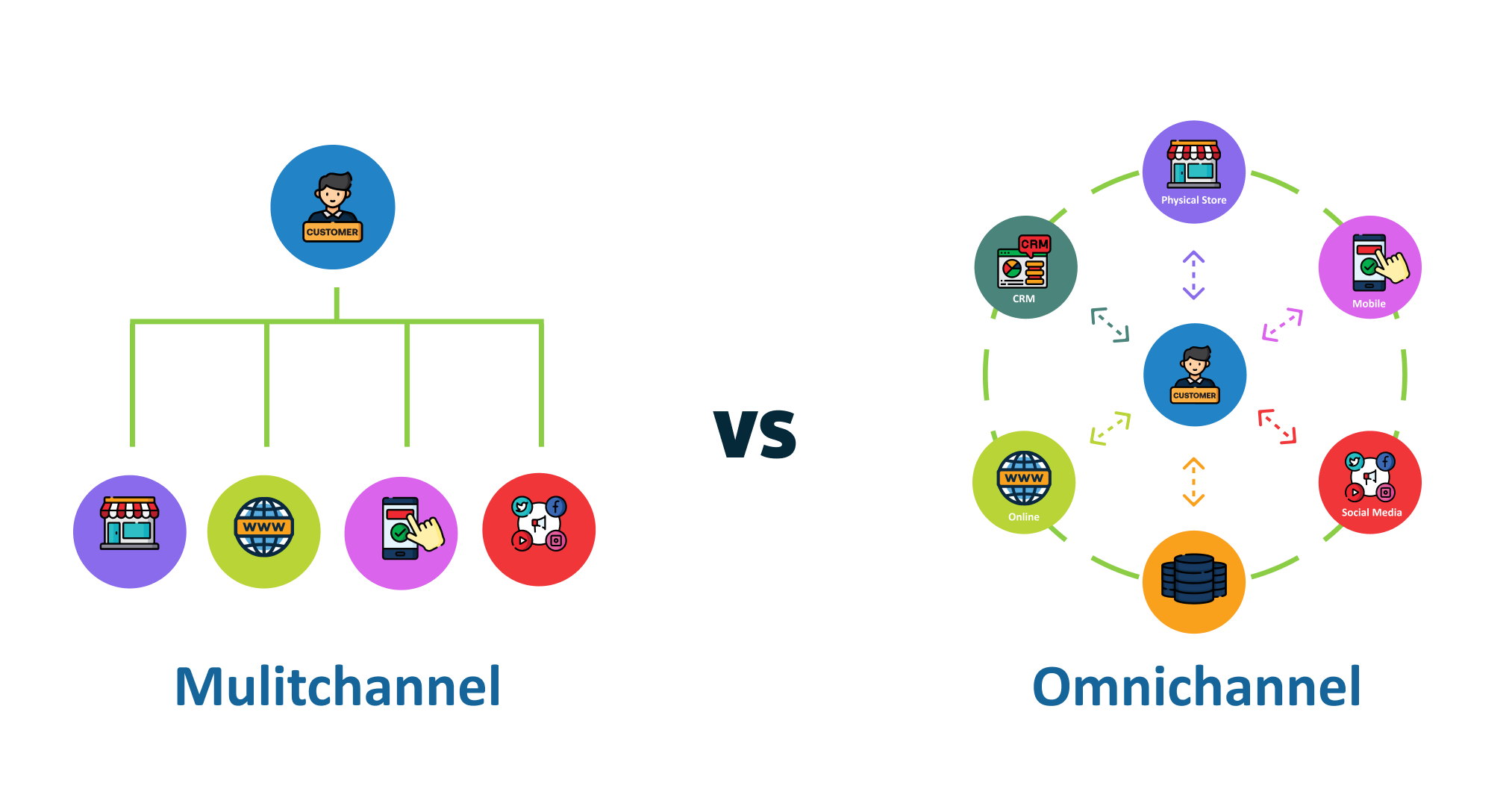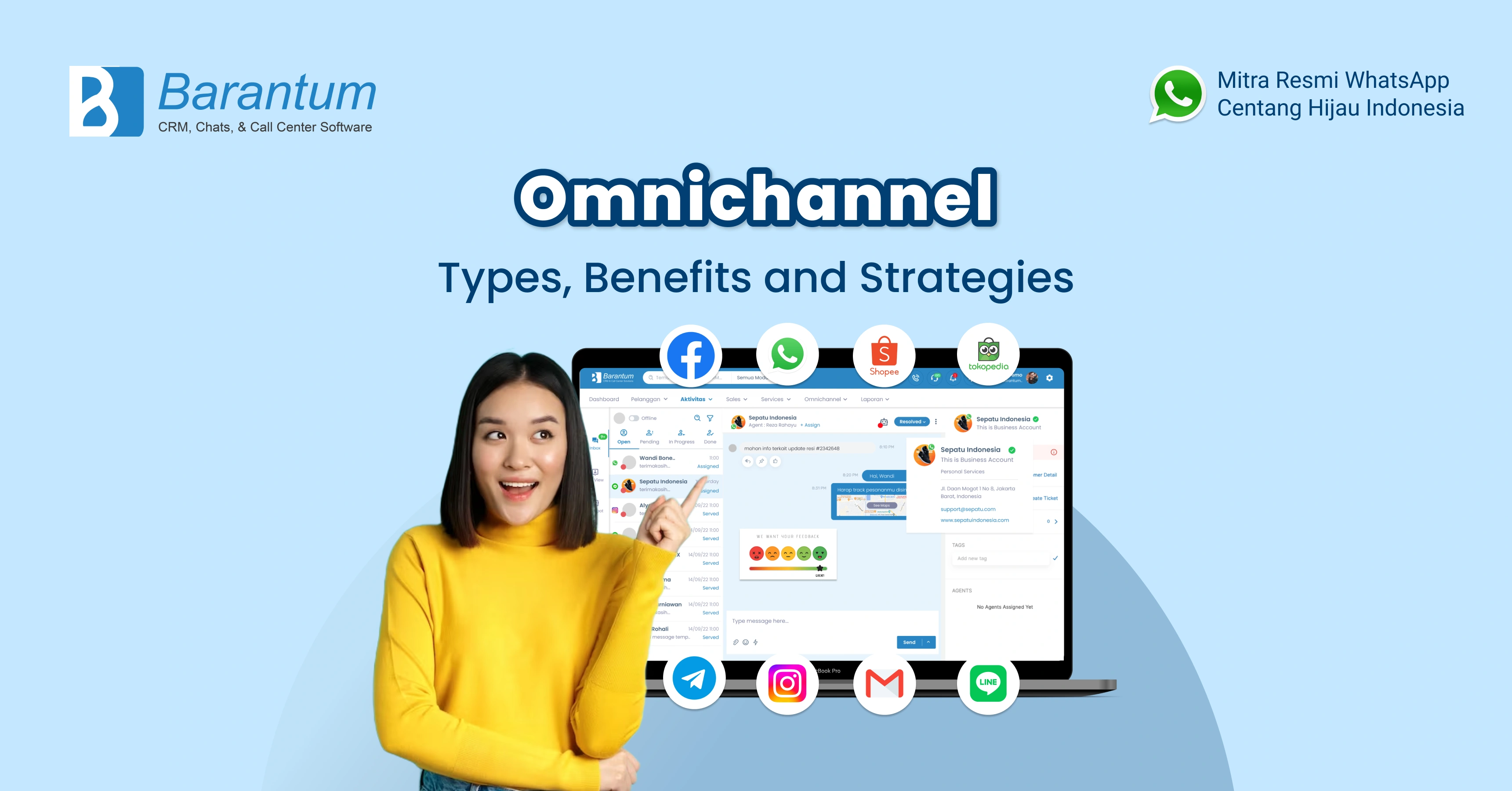Daftar Isi
About Omnichannel You Need to Know
Reaching a wide range of customers across various channels and achieving high customer satisfaction is the goal of every business. In doing so, the opportunity to attain high sales revenue becomes more readily achievable.
One strategy to simultaneously reach many customers across various channels with high customer satisfaction is through the use of omnichannel strategy.
What is omnichannel? What are its advantages and how does it work? To find out, make sure to read this article until the end. Read on!
What is Omnichannel?
Omnichannel is a system that integrates various communication channels into one platform. With the omnichannel strategy, the main goal is to enhance the customer experience by optimizing the utilization of various available communication media channels.
Omnichannel originates from two words, namely ‘omni’ and ‘channel.’ Omni means all or universal, while channel refers to a medium. This means combining all channels (media) where customers can find and connect with businesses across various channels, similar to multichannel but with a better and higher level of customer experience.
Omnichannel is an advanced stage in the evolution of multichannel: broader, updated in real-time for end-users. This system combines the most relevant communication channels at a given time with the customers. Instead of working in parallel, communication channels and supporting resources are designed to collaborate.
Types of Omnichannel
There are three categories of omnichannel: social media omnichannel, e-commerce omnichannel, and call center omnichannel. Here are their explanations:
1. Social Media Omnichannel
Social media omnichannel refers to using social media channels as part of the business approach. In this case, companies ensure that customers can be quickly served on various social media platforms such as WhatsApp, Facebook, Instagram, Twitter, Line, and Telegram. An integrated system for this purpose is Barantum.
2. E-commerce Omnichannel
E-commerce omnichannel is an e-commerce system that employs an omnichannel approach to selling products and services to customers. This system can provide services through various e-commerce platforms. As a recommendation, you can use Barantum Omnichannel, which can be integrated into various communication channels. As an innovation, Barantum can also integrate with other communication channels, such as Shopee and Tokopedia, providing a diverse range of integration options.
3. Call Center Omnichannel
Finally, there is call center omnichannel. This is a telephone service center that uses an omnichannel approach in providing services to customers. With this system, you can record every conversation between agents and customers, allowing for evaluations to provide better service. One of the best omnichannel call center service providers in Indonesia is Barantum.
Benefits of Omnichannel
Omnichannel benefits include making it easier for customers to shop and access product information on a single page, simplifying the company’s interactions with customers.
In addition, here are some benefits of using omnichannel strategy:
1. Expanding Customer Reach
By utilizing various channels and platforms, you can more easily reach potential customers. Providing consistency and easy access across all channels can attract and retain a broader customer base, helping to increase market share and business growth. With this system, your staff can reach many customers at once.
2. Improving Customer Satisfaction
This system allows customers to choose the channel that best suits their preferences and needs. Customer information is integrated across all channels, enabling your company to provide a personalized and relevant experience. By providing easy access and responsive service, you can create higher customer satisfaction, build loyalty, and increase customer retention. This helps you retain existing customers, attract new ones, and create long-term mutually beneficial relationships.
3. Boosting Customer Recommendations
Now that you know how to increase customer satisfaction with this system, your company has taken a step up to increased sales. Satisfied customers will boost your company’s brand. Satisfied customers will recommend your company to their peers, increasing your chances of gaining more customers.
4. Enhancing Work Efficiency
By integrating all communication channels, such as phone, email, and social media, into one centralized platform, your team can easily track and respond to customer requests quickly and efficiently. This avoids information loss or response overlaps, which can hinder productivity.
Additionally, with customer data integration across all channels, your team can have a better understanding of customer preferences and purchase history, allowing for more personalized service.
How Does Omnichannel Work?
The way omnichannel works is by combining all channels owned by the company into one centralized platform, ensuring consistent responses to all inquiries without any being overlooked. This allows your staff to effectively respond to customer inquiries from various channels.
Consider the difference between two companies, A and B. Company A utilizes omnichannel in its business. With this application, the business staff can respond to customers quickly, distributing customer messages evenly. Thus, no staff member is overwhelmed with their workload.
By using this system, your staff can answer all customer questions from different communication channels. The result? Customer satisfaction with company A is undoubtedly high.
On the other hand, company B does not use omnichannel. However, they follow social media developments similar to company A. As a result, company B’s staff needs to open each business account on various communication channels one by one. Needless to say, this is inconvenient, especially if the incoming messages are numerous.
As a result, company B’s customers feel that the staff is unresponsive. Despite the efforts of the company’s staff to answer customer questions, customers feel unsatisfied.
So, which company would you prefer? Certainly, company A with a better system for more effective work.
At first glance, the way omnichannel works seems similar to multichannel, which uses various media to attract and interact with customers. However, in this system, all communication channels can be integrated with each other, unlike multichannel.
Difference Between Omnichannel and Multichannel


The core difference between omnichannel and multichannel lies in their focus. Omnichannel is more customer-oriented, aiming to provide an integrated and consistent experience, while multichannel focuses more on product availability across different channels.
Omnichannel places the customer at the center, aiming to provide a consistent and integrated experience across all communication channels. This allows customers to interact with your agents without obstacles and have a positive experience. On the other hand, multichannel focuses on product availability across various channels. Prioritizing products in multichannel means that product availability is a priority, and customers often find different prices or offers on each channel.
Effective Omnichannel Strategies in Business
A good omnichannel strategy involves seamless integration of various communication channels and customer interaction. First, ensure that customer data is collected and centralized, allowing simultaneous access across all channels. With consistent visibility into customer preferences, purchase history, and behavior across all channels, businesses can provide a more personalized and relevant experience.
Additionally, it is important to provide continuity in the customer journey. This means customers can switch from one channel to another without hindrance or loss of information. For example, if a customer starts product search on the website and then wants to continue the purchase in a physical store, their data and preferences should be integrated for a seamless experience.
Another strategy to consider is omnichannel marketing. Omnichannel marketing is a strategic approach performed with consistency and coordination, especially in interacting with customers and potential customers.
In this strategy, businesses can use various channels to communicate and interact with customers. For instance, marketing campaigns can be conducted via email, text messages, social media, or advertisements. It’s essential to maintain consistency in messages and offers across all channels, creating a sense of continuity from one channel to another. Moreover, with integrated customer data, businesses can send relevant and personalized messages based on customer preferences and history.
So, what are the benefits for sellers?
For online store owners, omnichannel allows businesses to know instantly which products their customers will buy. Store owners can also find out what activities buyers engaged in before visiting the store and deciding to make a purchase. In this regard, you can gather customer data for the store owner.
Not only that, but this strategy can integrate communication services into one platform. Therefore, if there are questions or complaints from customers, they can be responded to quickly without having to open multiple business account applications.
How to Optimize Omnichannel Strategy?
Integrating the omnichannel strategy with Customer Relationship Management (CRM) systems opens the door for businesses to enhance customer interaction management and marketing effectiveness. Firstly, integrating customer data from various channels into the CRM system allows the company to have consistent visibility into customer interaction history. This helps the team identify customer preferences and behavior, enabling the design of more targeted marketing strategies and better personalization for an improved experience.
Moreover, this integration enables better monitoring of customer service performance. By aligning customer service data with the CRM system, management can understand responses and issue resolutions more efficiently. They can monitor customer satisfaction levels and identify opportunities to improve service quality. Additionally, integration with sales data allows in-depth analysis of sales performance across various channels, helping the company measure the effectiveness of marketing strategies and adjust them as needed.
Lastly, using integrated information from CRM for personalized marketing is possible. Businesses can design more effective marketing campaigns by customizing special offers based on recorded customer preferences and behavior. With a deeper understanding of customers and overall business performance, companies can optimize marketing and customer service strategies for long-term success. Omnichannel and CRM integration is not just about a quick response to customer inquiries; it’s about taking business management to the next level with integrated and measurable information.
Choose an omnichannel system that can integrate with CRM, preferably from a reliable provider like Barantum.
Barantum provides end-to-end solutions with Omnichannel features that can connect WhatsApp API and other chat applications with the Customer Relationship Management system.
The All-in-One Solutions CRM technology in Barantum CRM has helped thousands of companies boost HR performance, increase sales, improve productivity, and enhance customer service.



